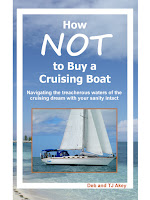Yesterday's
first look at the impeller gave rise to the thought of just leaving
it alone. It looked new. Even as good as Oak Harbor has been to us
we have been in this place for far too many weeks. The boat is in
the water. The summer is rushing by. There are other tasks that
need finished before we can go. Why waste a day doing something that
doesn't need done? But changing the impeller is routine maintenance,
this one was at least a couple of years old, and the cover was
already off. So I grabbed it with the recommended pliers and pulled,
which is when I discovered it was stuck. After rejecting the first
thought of just letting it be, I pulled the pump out, set it on the
bench, and let it soak in PB Blaster over night. (Not the whole
pump, just where the impeller goes on the shaft.)
This
morning Deb scrounged up the recommended JABSCO impeller puller which
only managed to rip the rubber blade assembly off of its bronze
insert. After some very esoteric attempts at making the puller work,
then disassembling the pump from the wrong end backwards (I'm not
sure how else to describe it) with the aid of a 12 ton press, the
offending impeller insert was finally freed from the exposed shaft
with the adroit ministrations of a disk grinder. None of this falls
under the heading of “routine maintenance” and the disassembled
parts now cover my work bench.
 |
| The 5320-0011 guts with which we are becoming all to familiar |
The
odd thing is I almost just let it be, and am not entirely sure why I
didn't. The pump was working fine. The Beast, ever since the heat
exchanger overhaul, runs at a content 178 degrees and spits plenty of
water. There was no evidence that the pump was leaking and no
compelling reason to do anything with it, particularly with the other
tasks that are still hanging. But a subtle shove had me tripping
over the impeller, and the rest unfolded like it was scripted. Had
the impeller not been frozen I would never have noticed the other,
impending, failures. It is hard to say how before they would have
happened, but this time around we hope to be in the water for nearly
three years without a major maintenance stop. We hope to be in some
places where a pump failure could be a very big deal indeed. There is
very little chance it would have gone that long, and a reasonable
chance that it would have failed in one of those places. I don't
know why I got tangled up with this pump, but I'm glad I did.
Maybe
its left over from my aviation days. The best mechanics I worked
with always wanted to know the “why” of a failure. Why did this
wheel bearing fail inspection while the other nine passed? Why this
crack in this place? What is that noise, that odd color, that
strange odor? Needing to understand was a habit, nearly an
obsession. They didn't miss much and I always felt comfortable
flying the airplanes they maintained.
It appears to be a good habit to practice around boats as well.
The
impeller was stuck. It isn't a particularly good design and looks
susceptible to just such a failure. As it turns out (long story)
the impeller puller would never work as advertised on this particular
unit. If the impeller gets jammed, there is no getting it free short
of taking the pump apart wrong way backwards. But I understand the
“why” of it now, and learned that the pump was deep into its service life. When we leave here that will not be the case.
I'll
take that kind of shove any day.




































